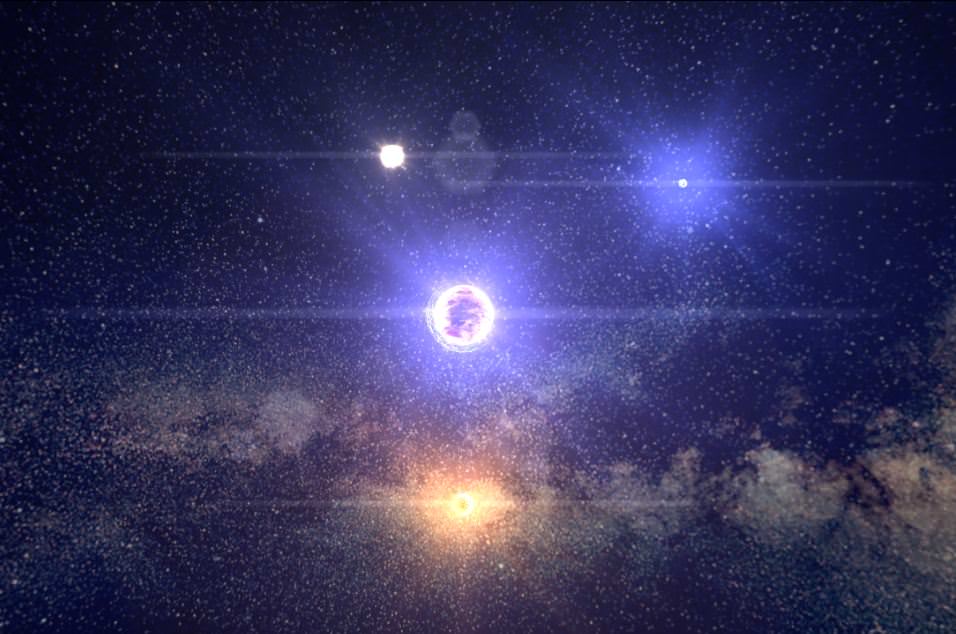Screenshot from 100,000 Stars
Want to explore the Milky Way? A new visualization tool from Google called 100,000 Stars lets you take a tour of our cosmic neighborhood, and with a few clicks of your mouse you can zoom in, out and around and do a little learning along the way. Zoom in to learn the names of some of the closest stars; click on the names to find out more information about them.
Playing with it is great fun, and I’ve been experimenting with it for a while. The most important caveat about 100,000 Stars is that you need to run it in Chrome. It’s from the Chrome Experiment team, and it uses imagery and data from NASA and ESA, but the majority of what you are seeing are artist’s renditions.
The best way to get started is to click on the Take the Tour in the upper left hand corner.
But if you just want to zoom in, you can see the closest stars to us. The Sun is in the middle, and if you zoom in even further, you’ll see the Oort Cloud. Keep zooming in to find the planetary orbits (I was struck by how much zooming had to be done to get to the planets, giving a sense of scale).
It includes some nifty spacey-like music (provided by Sam Hulick, who video game fans may recognize as a composer for the popular space adventure series, Mass Effect) but if you’d rather explore in silence, hit your mute button.
What I enjoyed the most is moving my mouse up and down to see the 3-D effect of how everything fits together, providing a sense of the cosmic web that holds our universe together.


Astrogasm!
This program doesn’t show Alpha centauri A & B, or the barred nature of the galaxy. It also shows more of a globular cluster area around sol, instead of the galaxy’s arm branches. It’s not very accurate.
Cool program, I like the graphics. I did find a flaw however. I couldn’t find Sirius, which is one of the closest stars to the sun. I never heard of a nearby star named Alpha Cassiopeiae so I clicked it, and it gave me info on Sirius.
wait for it…..
You can’t be Sirius!
Sirius, Schedar, Alpha Cassiopea, Alpha Canis Majoris, whatever…
They are just big round balls of gas that happen to fuse hydrogen anyway.
The program is a neat concept as such an interactive map is long overdue for the public, especially with many exoplanets being found around nearby stars. It appears, however that there may be some bugs to squash.
It’s missing Tau Ceti…
“Warning: Scientific accuracy is not guaranteed. Please do not use this visualization for interstellar navigation.”
Great disclaimer, good to see the lawyers spotted that potential liability!!
Again, as above, I saw that too – I would again, go with CELESTIA if you want VISUAL and ACCURACY. Kind of sad to for GOOGLE, I guess I expected, wrongly, a little better from them. Not like they do not have the $$$ to do it right.
The Apple Maps of space…?
It seems to run just as well in Firefox.
Nice but Celestia is better
Yes, CELESTIA is many times better and far more accurate. I would go with it FIRST – SECOND and THIRD.
Globular Cluster outer-edge scene, appears the opening screen. Loved its 3-D effect of varicolored stars sliding-by. It seemed limiting to foreground motion, though: the background mass remaining unmoved in passage (as distant Mountain “motionless” from traveling car?). — Nice.
A 3-D orbital animation (or navigable program capable of showing all relative motions and perspectives) of the Local Star Group (LSG) configuration, from say 100+ l.y.’s out, representing all their positions and comparative scales, as glowing spheres (rather than lens-haloed stars) against Space-black backdrop, could be very attractive. Perhaps more impressive, imagine large Planetarium exhibit (hat-box shaped?), within which the fixed (or motion-driven) LSG constellation suspends in darkness, radiant in spectral-colors. A large display surrounded by walkway. A beautiful work of Science-Art, such an enclosure could present.
Have yet to see a satisfying graphic or video of the LSG.
This is awesome. Some tips however:
1) Running Chrome on WinXP the labels are much too small to read, I am clicking on stars mostly blind except for the length of their names
2) A string search, e.g. “Sinistra” to get to “Sinistra nu Ophiuchi” would be very helpful.
3) Zoom in to a distance equal to twice the diameter of the star, that way the screen isn’t simply filled with stellar core. The icons are lost in the glare.
This is phenomenal, thanks!
Eye candy only not for research purposes. Still very good google!
You can also try http://www.3dgalaxymap.com/Galaxy/
It is a mix of the Hipparcos, Gliese and Tycho catalogues, totaling over 142000 stars. Exoplanets are updated daily from the exoplanet.eu site, if a matching star is found as a parent for the planet.
It’s pretty, but it doesn’t come close to Celestia, which is more accurate, allows you to visit stars, planets easily, can be updated to show exoplanets, and customized.